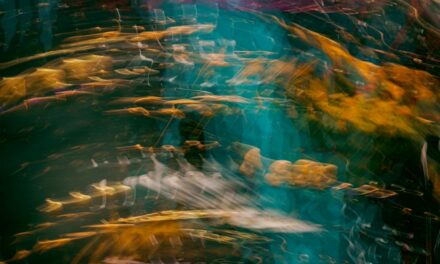In the realm of watercolour painting, the concept of soft edges plays a pivotal role in creating depth, atmosphere, and a sense of realism. Soft edges refer to the gentle transitions between colours and forms, which can evoke a sense of movement and fluidity that is characteristic of this medium. Unlike the hard edges often found in other painting techniques, soft edges allow for a more organic representation of subjects, making them appear more lifelike and engaging.
This technique is particularly effective in capturing the subtleties of light and shadow, as well as the delicate nuances of natural forms such as flowers, landscapes, and human figures. Moreover, soft edges can significantly enhance the emotional impact of a painting. By employing this technique, artists can create a sense of tranquillity or dreaminess, inviting viewers to immerse themselves in the artwork.
The ability to manipulate edges not only contributes to the overall composition but also guides the viewer’s eye through the piece. Understanding how to achieve and utilise soft edges is therefore essential for any watercolour artist seeking to elevate their work and convey a more profound narrative or emotional resonance.
Summary
- Soft edges in watercolor are important for creating a sense of depth and atmosphere in your paintings.
- The wet-on-wet technique involves applying wet paint to a wet surface to achieve soft, blended edges.
- The dry brush technique uses a minimal amount of paint on a dry brush to blend and soften edges in watercolor.
- A misting bottle can be used to lightly spray water onto the paper to create soft edges and blend colours in watercolor.
- Layering and glazing techniques involve building up transparent washes of colour to soften and blend edges in watercolor paintings.
- Masking fluid can be used to preserve areas of the paper and create soft edges by blocking out paint.
- Experiment with different brushes, such as round, flat, and mop brushes, to find the best tool for blending and softening edges in watercolor.
- Practice and master soft edge blending by experimenting with different techniques and being patient with the process.
Wet-on-Wet Technique for Creating Soft Edges
The wet-on-wet technique is one of the most effective methods for achieving soft edges in watercolour painting. This approach involves applying wet paint onto a wet surface, allowing the colours to blend seamlessly into one another. When executed correctly, this technique can produce beautifully soft transitions that mimic the natural diffusion of light and colour found in nature.
To begin, an artist typically moistens the paper with clean water before introducing their chosen pigments. The key is to maintain a balance between wetness; if the paper is too dry, the paint will not spread adequately, while excessive moisture can lead to uncontrolled bleeding. As the colours mingle on the wet surface, artists can manipulate them using various tools, such as brushes or even their fingers, to create desired effects.
This method is particularly useful for painting skies, water reflections, or any subject that requires a gentle blending of hues. However, it is essential to work quickly, as watercolour dries relatively fast. Mastering the wet-on-wet technique requires practice and an understanding of how different pigments interact with one another when wet.
With time, artists can develop an intuitive sense for when to introduce new colours and how to control their flow for optimal soft edge effects.
Dry Brush Technique for Blending in Watercolour
While the wet-on-wet technique is celebrated for its ability to create soft edges through fluid blending, the dry brush technique offers a contrasting approach that can also yield stunning results. This method involves using a brush that is relatively dry—having little water or paint on it—to apply pigment onto the paper. The result is a more textured appearance that can still contribute to softening edges when used judiciously.
The dry brush technique is particularly effective for adding fine details or textures to areas that require a softer touch. For instance, when painting foliage or fur, artists can use this method to suggest softness while maintaining some definition.
It is important to note that achieving soft edges with a dry brush requires a delicate hand; too much pressure can lead to harsh lines rather than the desired gentle transitions. Therefore, practising this technique allows artists to develop control over their brushwork and understand how varying pressure and angle can influence the final outcome.
Using a Misting Bottle to Achieve Soft Edges
In addition to traditional painting techniques, artists can employ tools such as a misting bottle to enhance their ability to create soft edges in watercolour. A misting bottle allows for an even application of water over the painted surface, which can help rehydrate dried areas and facilitate blending. This technique is particularly useful when an artist wishes to soften edges after initial layers have dried.
By lightly misting the paper, they can reactivate pigments and encourage them to flow into one another, resulting in smoother transitions. Furthermore, using a misting bottle can also aid in creating atmospheric effects such as fog or haze. By applying a fine mist over certain areas of a painting, artists can achieve a sense of depth and distance that enhances the overall composition.
It is crucial to use this tool judiciously; too much moisture can lead to unwanted pooling or bleeding of colours. Therefore, understanding how to control the amount of mist applied is essential for achieving the desired soft edge effects without compromising the integrity of the artwork.
Layering and Glazing Techniques for Softening Edges
Layering and glazing are fundamental techniques in watercolour painting that can significantly contribute to achieving soft edges. Layering involves applying multiple washes of colour on top of one another, allowing each layer to dry before adding the next. This method enables artists to build depth and complexity within their work while maintaining soft transitions between colours.
By carefully selecting transparent pigments and applying them in thin layers, artists can create luminous effects that enhance the overall softness of their compositions. Glazing, on the other hand, refers specifically to applying a transparent wash over an already dried layer of paint. This technique allows for subtle adjustments in colour and tone without losing the underlying details.
When used strategically, glazing can soften harsh edges and create a more cohesive look throughout the painting. Both layering and glazing require patience and an understanding of colour theory; artists must be mindful of how different hues interact when layered and how transparency affects the final appearance. Mastering these techniques opens up new possibilities for creating soft edges while enriching the overall visual experience.
Utilizing Masking Fluid to Preserve Soft Edges
Masking fluid is an invaluable tool for watercolour artists seeking to preserve soft edges while working on complex compositions. This liquid latex substance can be applied to areas of the paper that an artist wishes to keep free from paint. Once dried, it acts as a barrier against watercolour pigments, allowing artists to paint around it without affecting those protected areas.
This technique is particularly useful when working on intricate details or highlights that require precision while still wanting to maintain soft transitions elsewhere in the piece. When using masking fluid, it is essential to apply it with care; a fine-tipped brush or even a dip pen can help achieve clean lines and shapes. After completing the painting process, artists can remove the masking fluid by gently rubbing it off with their fingers or an eraser, revealing untouched paper beneath.
This method allows for greater flexibility in creating soft edges around focal points while ensuring that important details remain intact. However, it is crucial to remember that masking fluid should be used sparingly; overuse can lead to a disjointed appearance if not integrated thoughtfully into the overall composition.
Experimenting with Different Brushes for Blending in Watercolour
The choice of brush plays a significant role in achieving soft edges in watercolour painting. Artists have access to a wide variety of brushes, each offering unique characteristics that can influence blending techniques. For instance, round brushes are versatile tools that can create both fine lines and broader strokes depending on how they are used.
Their ability to hold water and pigment makes them ideal for achieving soft transitions when used with techniques like wet-on-wet or glazing. Flat brushes are another excellent option for blending; their broad bristles allow for smooth washes over larger areas while still providing control for softer edges along borders. Additionally, fan brushes or mop brushes can be employed for more textured effects or when working on intricate details that require gentle blending.
Ultimately, understanding how various brushes interact with watercolour pigments will enhance an artist’s ability to manipulate edges effectively.
Tips for Practicing and Mastering Soft Edge Blending in Watercolour
To master the art of soft edge blending in watercolour painting, consistent practice is essential. Artists should dedicate time to experimenting with various techniques discussed earlier—such as wet-on-wet, dry brush, layering, glazing, and using misting bottles—while focusing specifically on edge transitions. Setting aside time for focused practice sessions allows artists to refine their skills without the pressure of completing a finished piece.
Additionally, studying works by accomplished watercolourists can provide valuable insights into how they achieve soft edges within their compositions. Analysing their techniques and understanding their approach can inspire new ideas and methods for one’s own practice. Keeping a sketchbook dedicated solely to experimenting with edge blending techniques can also be beneficial; this allows artists to document their progress and identify areas for improvement over time.
In conclusion, mastering soft edges in watercolour painting requires patience, experimentation, and an understanding of various techniques available within this versatile medium. By exploring methods such as wet-on-wet blending, dry brush application, misting bottles, layering and glazing techniques, masking fluid usage, and experimenting with different brushes, artists can develop their unique style while enhancing their ability to create captivating works filled with depth and emotion. With dedication and practice, anyone can learn to harness the power of soft edges in their watercolour paintings.
If you are interested in exploring different art techniques, you may also enjoy reading An Introduction to the Art Technique: Etching. This article delves into the fascinating world of etching, a printmaking technique that involves using acid to create intricate designs on metal plates. Learning about etching can provide valuable insights into the creative process and inspire new ideas for your own artistic endeavours.


